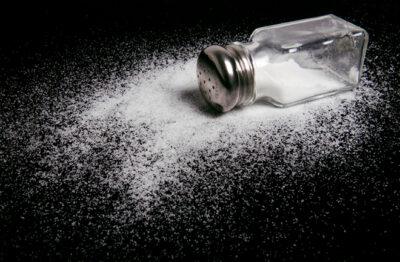Salt: It’s tasty. We crave it. We feast on salty potato chips, pizza and bacon. We like salt … a lot!
Unfortunately, many of the foods that contain salt, such as processed, fat-laden foods, also contain a multitude of deadly compounds such as saturated fats, preservatives and artificial ingredients. We are told that salt causes high blood pressure and aggravates PMS. Yet, we still consume and crave salt. Is salt all bad? Does salt offer any health benefits, or is salt a deadly ingredient in our diets? The truth is that salt is essential for life. Salt offers many health benefits.
The Story of Salt
Salt is comprised of two elements: sodium and chloride. Sodium and chloride are two poisonous gasses which, when combined, form the solid that we know as salt. Table salt may contain other minerals and have agents added to it to keep it free-flowing. Iodized salt contains iodine, a substance that the body requires. Salt also may contain minerals which are local to the area from which the salt is mined. Sea salt contains trace amounts of healthy minerals. Salt comes in a wide array of colors — white, pink and black, to name a few. These colors come from other minerals which are combined with the sodium chloride.
New All-Natural Capsule Protects You From Dangerous Toxins And Pollutants!
Sodium and Chloride are Electrolytes
Our blood is salty. In fact, if you ever need intravenous fluids, you are likely to be given a solution which helps restore the body’s normal levels of sodium and chloride. When you have your blood drawn and electrolyte levels are measured, sodium and chloride are two of the key substances which health care professionals monitor, as levels of electrolytes must be maintained within a narrow range for proper function. Imbalances of electrolytes, such as sodium and chloride, can prove fatal. Electrolyte balance is essential for every chemical process in the body to occur normally. Sodium and chloride help to keep the body tissues within the normal pH range that cells require to function.
Salt Maintains Body Fluid Balance, Including Blood Pressure
Much of the concern about salt is based upon its effects on liquids. Think about how you feel after eating salty food. What happens? You get thirsty. If you get thirsty, you drink to quench that thirst. On a cellular level, salt does the same thing. It makes the cells thirsty. Fluid moves about and accumulates, in a race to dilute the saltiness. If the cells are not working properly, tissues can become saturated, bloated and sluggish.
To keep the action of sodium in check, the body uses another substance, called potassium. If potassium and sodium levels are kept within balance, the individual cells, tissues and the entire body functions better.
Many researchers believe that a lack of potassium may be more likely to cause high blood pressure than too much sodium. This is a real problem, as the first line of medications which doctors and other health care providers prescribe to lower blood pressure are drugs called diuretics, or water pills. Diuretics rid the cells of excess fluids, hence blood pressure lowers. However, diuretics flush away potassium as well. Unless potassium levels are restored, serious complications may result.
Other Health Benefits of Sodium and Chloride (Salt)
Sodium is needed to ensure bone health, make muscles contract, and help nerves transmit messages.
The Hidden Secrets Of Making Herbal Medicines…Right At Your Fingertips!
Salt enhances the flow of blood, preventing blood vessels from clogging. It supports the movement of lymphatic fluid, so that the immune system is able to respond optimally. Chloride aids the function and distribution of hormones throughout the body.
Chloride is needed for the production of stomach acid and to ensure the proper function of the liver. A lack results in an inability to digest foods properly, and gastrointestinal disturbances, such as pain and gas.
Deficiency of Salt
Most people obtain enough salt in their diets. A deficiency of salt may result in weight loss, weakness, vomiting and muscle wasting. Arthritis and nerve pain is aggravated if salt is lacking. Salt tablets are used by professional athletes to relieve muscle cramps. Heat stroke may be prevented by ensuring adequate levels of salt intake on hot days.
A small percentage of salt in the diet comes from the salt shaker on the table. The vast majority of salt consumed comes from packaged and processed foods. Easily absorbable and healthy forms of salt are contained in meat, fruits and vegetables. Celery and onions are excellent sources of healthy salt.
What Does This Mean For You?
While some individuals who have health problems benefit from a salt-restricted diet, healthy individuals may use salt in moderation without negative consequences. More important than restricting salt is increasing your intake of foods high in potassium. Eat plenty of produce, and avoid processed foods. Read package labels. You will be amazed at how much salt processed foods and meats contain.
Sea salt is usually processed less than other salts. Try sprinkling powered kelp or another seaweed on foods. You will get salt plus other healthy micronutrients. If you have questions about how much salt is best for you, check with your health care provider.
Do you try and avoid too much salt? How do you maintain a healthy balance? Share your thoughts in the section below:
 Off The Grid News Better Ideas For Off The Grid Living
Off The Grid News Better Ideas For Off The Grid Living






